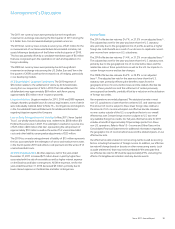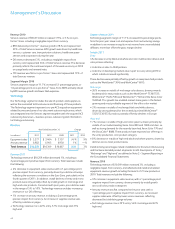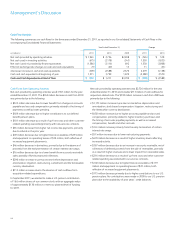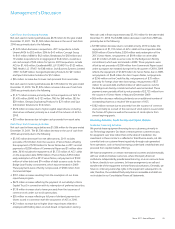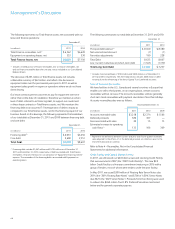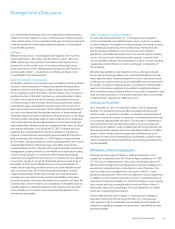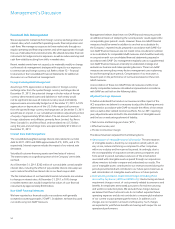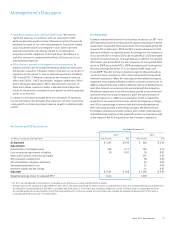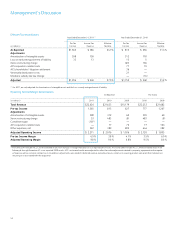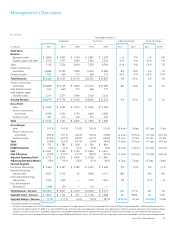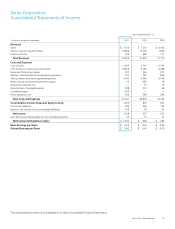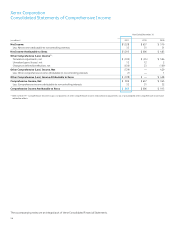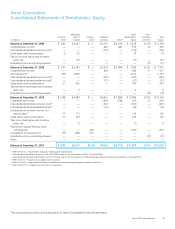Xerox 2011 Annual Report Download - page 51
Download and view the complete annual report
Please find page 51 of the 2011 Xerox annual report below. You can navigate through the pages in the report by either clicking on the pages listed below, or by using the keyword search tool below to find specific information within the annual report.Management’s Discussion
49Xerox 2011 Annual Report
OtherContingenciesandCommitments
As more fully discussed in Note 16 – Contingencies and Litigation
in the Consolidated Financial Statements, we are involved in a variety
of claims, lawsuits, investigations and proceedings concerning securities
law, intellectual property law, environmental law, employment law
and the Employee Retirement Income Security Act. In addition,
guarantees, indemnifications and claims may arise during the ordinary
course of business from relationships with suppliers, customers and
non-consolidated affiliates. Nonperformance under a contract including
a guarantee, indemnification or claim could trigger an obligation of
the Company.
We determine whether an estimated loss from a contingency should
be accrued by assessing whether a loss is deemed probable and can be
reasonably estimated. Should developments in any of these areas cause
a change in our determination as to an unfavorable outcome and result in
the need to recognize a material accrual, or should any of these matters
result in a final adverse judgment or be settled for significant amounts,
they could have a material adverse effect on our results of operations, cash
flows and financial position in the period or periods in which such change
in determination, judgment or settlement occurs.
Unrecognized Tax Benefits
As of December 31, 2011, we had $225 million of unrecognized tax
benefits. This represents the tax benefits associated with various tax
positions taken, or expected to be taken, on domestic and international
tax returns that have not been recognized in our financial statements due
to uncertainty regarding their resolution. The resolution or settlement of
these tax positions with the taxing authorities is at various stages and
therefore we are unable to make a reliable estimate of the eventual cash
flows by period that may be required to settle these matters. In addition,
certain of these matters may not require cash settlement due to the
existence of credit and net operating loss carryforwards, as well as other
offsets, including the indirect benefit from other taxing jurisdictions that
may be available.
Off-Balance Sheet Arrangements
Although we rarely utilize off-balance sheet arrangements in our
operations (as defined by the SEC Financial Reporting Release 67 (FRR-
67), “Disclosure in Management’s Discussion and Analysis about Off-
Balance Sheet Arrangements and Aggregate Contractual Obligations”),
we enter into operating leases in the normal course of business. The
nature of these lease arrangements is discussed in Note 6 – Land,
Buildings and Equipment, Net in the Consolidated Financial Statements.
In addition, we have facilities primarily in the U.S., Canada and several
countries in Europe that enable us to sell to third parties, on an ongoing
basis, certain accounts receivable without recourse. Refer to Note 4 –
Receivables, Net in the Consolidated Financial Statements for further
information regarding these facilities.
See the table above for the Company’s contractual cash obligations
and other commercial commitments and Note 16 – Contingencies
and Litigation in the Consolidated Financial Statements for additional
information regarding contingencies, guarantees, indemnifications and
warranty liabilities.
Our retiree health benefit plans are non-funded and are almost entirely
related to domestic operations. Cash contributions are made each year to
cover medical claims costs incurred during the year. The amounts reported
in the above table as retiree health payments represent our estimate of
future benefit payments.
FujiXerox
We purchased products, including parts and supplies, from Fuji Xerox
totaling $2.2 billion, $2.1 billion and $1.6 billion in 2011, 2010 and
2009, respectively. Our purchase commitments with Fuji Xerox are
entered into in the normal course of business and typically have a
lead time of three months. Related-party transactions with Fuji Xerox
are discussed in Note 7 – Investments in Affiliates, at Equity in the
Consolidated Financial Statements.
BrazilTaxandLaborContingencies
Our Brazilian operations are involved in various litigation matters and have
received or been the subject of numerous governmental assessments
related to indirect and other taxes, as well as disputes associated with
former employees and contract labor. The tax matters, which comprise a
significant portion of the total contingencies, principally relate to claims
for taxes on the internal transfer of inventory, municipal service taxes
on rentals and gross revenue taxes. We are disputing these tax matters
and intend to vigorously defend our positions. Based on the opinion of
legal counsel and current reserves for those matters deemed probable of
loss, we do not believe that the ultimate resolution of these matters will
materially impact our results of operations, financial position or cash flows.
The labor matters principally relate to claims made by former employees
and contract labor for the equivalent payment of all social security and
other related labor benefits, as well as consequential tax claims, as if they
were regular employees. As of December 31, 2011, the total amounts
related to the unreserved portion of the tax and labor contingencies,
inclusive of related interest, amounted to approximately $1,120 million,
with the decrease from December 31, 2010 balance of approximately
$1,274 million, primarily related to currency and adjustments from closed
cases partially offset by interest and new cases. With respect to the
unreserved balance of $1,120 million, the majority has been assessed by
management as being remote as to the likelihood of ultimately resulting
in a loss to the Company. In connection with the above proceedings,
customary local regulations may require us to make escrow cash deposits
or post other security of up to half of the total amount in dispute. As of
December 31, 2011 we had $240 million of escrow cash deposits for
matters we are disputing, and there are liens on certain Brazilian assets
with a net book value of $16 million and additional letters of credit
of approximately $237 million, which include associated indexation.
Generally, any escrowed amounts would be refundable and any liens
would be removed to the extent the matters are resolved in our favor. We
routinely assess all these matters as to probability of ultimately incurring
a liability against our Brazilian operations and record our best estimate
of the ultimate loss in situations where we assess the likelihood of an
ultimate loss as probable.


